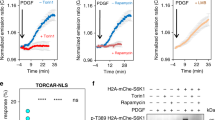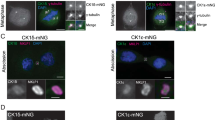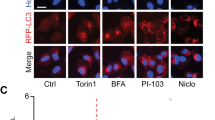Abstract
Many extracellular signal–regulated kinase (ERK) mitogen-activated protein (MAP) kinase substrates have been identified, but the diversity of ERK-mediated processes suggests the existence of additional targets. Using a phosphoproteomic approach combining the steroid receptor fusion system, IMAC, 2D-DIGE and phosphomotif-specific antibodies, we detected 38 proteins showing reproducible phosphorylation changes between ERK-activated and ERK-inhibited samples, including 24 new candidate ERK targets. ERK directly phosphorylated at least 13 proteins in vitro. Of these, Nup50 was verified as a bona fide ERK substrate. Notably, ERK phosphorylation of the FG repeat region of Nup50 reduced its affinity for importin-β family proteins, importin-β and transportin. Other FG nucleoporins showed a similar functional change after ERK-mediated phosphorylation. Nuclear migration of importin-β and transportin was impaired in ERK-activated, digitonin-permeabilized cells, as a result of ERK phosphorylation of Nup50. Thus, we propose that ERK phosphorylates various nucleoporins to regulate nucleocytoplasmic transport.
This is a preview of subscription content, access via your institution
Access options
Subscribe to this journal
Receive 12 print issues and online access
$189.00 per year
only $15.75 per issue
Buy this article
- Purchase on Springer Link
- Instant access to full article PDF
Prices may be subject to local taxes which are calculated during checkout








Similar content being viewed by others
References
Ubersax, J.A. & Ferrell, J.E. Mechanisms of specificity in protein phosphorylation. Nat. Rev. Mol. Cell Biol. 8, 530–541 (2007).
Johnson, S.A. & Hunter, T. Kinomics: methods for deciphering the kinome. Nat. Methods 2, 17–25 (2005).
Cohen, P. & Knebel, A. KESTREL: a powerful method for identifying the physiological substrates. Biochem. J. 393, 1–6 (2006).
Eblen, S.T. et al. Identification of novel ERK2 substrates through use of an engineered kinase and ATP analogs. J. Biol. Chem. 278, 14926–14935 (2003).
Fukunaga, R. & Hunter, T. Identification of MAPK substrates by expression screening with solid-phase phosphorylation. Methods Mol. Biol. 250, 211–236 (2004).
Ptacek, J. et al. Global analysis of protein phosphorylation in yeast. Nature 438, 679–684 (2005).
Mann, M. Functional and quantitative proteomics using SILAC. Nat. Rev. Mol. Cell Biol. 7, 952–958 (2006).
Olsen, J.V. et al. Global, in vivo, and site-specific phosphorylation dynamics in signaling networks. Cell 127, 635–648 (2006).
Matsuoka, S. et al. ATM and ATR substrate analysis reveals extensive protein networks responsive to DNA damage. Science 316, 1160–1166 (2007).
Görg, A., Weiss, W. & Dunn, M.J. Current two-dimensional electrophoresis technology for proteomics. Proteomics 4, 3665–3685 (2004).
Oh, P. et al. Subtractive proteomic mapping of the endothelial surface in lung and solid tumours for tissue-specific therapy. Nature 429, 629–635 (2004).
Stasyk, T. et al. Phosphoproteome profiling of transforming growth factor (TGF)-β signaling: Abrogation of TGFβ1-dependent phosphorylation of transcription factor-II-I (TFII-I) enhances cooperation of TFII-I and Smad3 in transcription. Mol. Biol. Cell 16, 4765–4780 (2005).
Collins, M.O. et al. Proteomics analysis of in vivo phosphorylated synaptic proteins. J. Biol. Chem. 280, 5972–5982 (2005).
Dubrovska, A. & Souchelnytskyi, S. Efficient enrichment of intact phosphorylated proteins by modified immobilized metal-affinity chromatography. Proteomics 5, 4678–4683 (2005).
Machida, M. et al. Purification of phosphoproteins by immobilized metal affinity chromatography and its application to phosphoproteome analysis. FEBS J. 274, 1576–1587 (2007).
Ueda, K., Kosako, H., Fukui, Y. & Hattori, S. Proteomic identification of Bcl2-associated athanogene 2 as a novel MAPK-activated protein kinase 2 substrate. J. Biol. Chem. 279, 41815–41821 (2004).
Timms, J.F. & Cramer, R. Difference gel electrophoresis. Proteomics 8, 4886–4897 (2008).
Tang, W. et al. BSKs mediate signal transduction from the receptor kinase BRI1 in Arabidopsis. Science 321, 557–560 (2008).
Lewis, T.S., Shapiro, P.S. & Ahn, N.G. Signal transduction through MAP kinase cascades. Adv. Cancer Res. 74, 49–139 (1998).
Pearson, G. et al. Mitogen-activated protein (MAP) kinase pathways: regulation and physiological functions. Endocr. Rev. 22, 153–183 (2001).
Yoon, S. & Seger, R. The extracellular signal-regulated kinase: multiple substrates regulate diverse cellular functions. Growth Factors 24, 21–44 (2006).
Lewis, T.S. et al. Identification of novel MAP kinase pathway signaling targets by functional proteomics and mass spectrometry. Mol. Cell 6, 1343–1354 (2000).
Roberts, E.C., Hammond, K., Trish, A.M., Resing, K.A. & Ahn, N.G. Identification of G2/M targets for the MAP kinase pathway by functional proteomics. Proteomics 6, 4541–4553 (2006).
Allen, J.J. et al. A semisynthetic epitope for kinase substrates. Nat. Methods 4, 511–516 (2007).
Fahrenkrog, B. & Aebi, U. The nuclear pore complex: nucleocytoplasmic transport and beyond. Nat. Rev. Mol. Cell Biol. 4, 757–766 (2003).
Terry, L.J., Shows, E.B. & Wente, S.R. Crossing the nuclear envelope: hierarchical regulation of nucleocytoplasmic transport. Science 318, 1412–1416 (2007).
Onischenko, E.A., Gubanova, N.V., Kiseleva, E.V. & Hallberg, E. Cdk1 and okadaic acid-sensitive phosphatases control assembly of nuclear pore complexes in Drosophila embryos. Mol. Biol. Cell 16, 5152–5162 (2005).
Pritchard, C.A., Samuels, M.L., Bosch, E. & McMahon, M. Conditionally oncogenic forms of the A-Raf and B-Raf protein kinases display different biological and biochemical properties in NIH 3T3 cells. Mol. Cell. Biol. 15, 6430–6442 (1995).
Manning, B.D., Tee, A.R., Logsdon, M.N., Blenis, J. & Cantley, L.C. Identification of the tuberous sclerosis complex-2 tumor suppressor gene product tuberin as a target of the phosphoinositide 3-kinase/Akt pathway. Mol. Cell 10, 151–162 (2002).
Gonzalez, F.A., Raden, D.L. & Davis, R.J. Identification of substrate recognition determinants for human Erk1 and Erk2 protein kinases. J. Biol. Chem. 266, 22159–22163 (1991).
Czubryt, M.P., Austria, J.A. & Pierce, G.N. Hydrogen peroxide inhibition of nuclear protein import is mediated by the mitogen-activated protein kinase, ERK2. J. Cell Biol. 148, 7–16 (2000).
Matsubayashi, Y., Fukuda, M. & Nishida, E. Evidence for existence of a nuclear pore complex-mediated, cytosol-independent pathway of nuclear translocation of ERK MAP kinase in permeabilized cells. J. Biol. Chem. 276, 41755–41760 (2001).
Whitehurst, A.W. et al. ERK2 enters the nucleus by a carrier-independent mechanism. Proc. Natl. Acad. Sci. USA 99, 7496–7501 (2002).
Matsuura, Y. & Stewart, M. Nup50/Npap60 function in nuclear protein import complex disassembly and importin recycling. EMBO J. 24, 3681–3689 (2005).
Lindsay, M.E., Plafker, K., Smith, A.E., Clurman, B.E. & Macara, I.G. Npap60/Nup50 is a tri-stable switch that stimulates importin-α:β-mediated nuclear protein import. Cell 110, 349–360 (2002).
Hase, M.E. & Cordes, V.C. Direct interaction with Nup153 mediates binding of Tpr to the periphery of the nuclear pore complex. Mol. Biol. Cell 14, 1923–1940 (2003).
Harel, A. & Forbes, D.J. Importin β: conducting a much larger cellular symphony. Mol. Cell 16, 319–330 (2004).
Stewart, M. Molecular mechanism of the nuclear protein import cycle. Nat. Rev. Mol. Cell Biol. 8, 195–208 (2007).
Kinoshita-Kikuta, E., Aoki, Y., Kinoshita, E. & Koike, T. Label-free kinase profiling using phosphate affinity polyacrylamide gel electrophoresis. Mol. Cell. Proteomics 6, 356–366 (2007).
Kose, S., Imamoto, N., Tachibana, T., Shimamoto, T. & Yoneda, Y. Ran-unassisted nuclear migration of a 97-kD component of nuclear pore-targeting complex. J. Cell Biol. 139, 841–849 (1997).
Gerner, C. et al. The Fas-induced apoptosis analyzed by high throughput proteome analysis. J. Biol. Chem. 275, 39018–39026 (2000).
Glavy, J.S. et al. Cell-cycle-dependent phosphorylation of the nuclear pore Nup107–160 subcomplex. Proc. Natl. Acad. Sci. USA 104, 3811–3816 (2007).
Smolka, M.B., Albuquerque, C.P., Chen, S.H. & Zhou, H. Proteome-wide identification of in vivo targets of DNA damage checkpoint kinases. Proc. Natl. Acad. Sci. USA 104, 10364–10369 (2007).
Lee, T. et al. Docking motif interactions in MAP kinases revealed by hydrogen exchange mass spectrometry. Mol. Cell 14, 43–55 (2004).
Vomastek, T. et al. Extracellular signal-regulated kinase 2 (ERK2) phosphorylation sites and docking domain on the nuclear pore complex protein Tpr cooperatively regulate ERK2-Tpr interaction. Mol. Cell. Biol. 28, 6954–6966 (2008).
Iwamatsu, A. S-Carboxymethylation of proteins transferred onto polyvinylidene difluoride membranes followed by in situ protease digestion and amino acid microsequencing. Electrophoresis 13, 142–147 (1992).
Funakoshi, T. et al. Two distinct human POM121 genes: requirement for the formation of nuclear pore complexes. FEBS Lett. 581, 4910–4916 (2007).
Gu, Y., Hamajima, N. & Ihara, Y. Neurofibrillary tangle-associated collapsin response mediator protein-2 (CRMP-2) is highly phosphorylated on Thr-509, Ser-518, and Ser-522. Biochemistry 39, 4267–4275 (2000).
Imamoto, N. et al. The nuclear pore-targeting complex binds to nuclear pores after association with a karyophile. FEBS Lett. 368, 415–419 (1995).
Adam, S.A., Sterne-Marr, R. & Gerace, L. Nuclear protein import in permeabilized mammalian cells requires soluble cytoplasmic factors. J. Cell Biol. 111, 807–816 (1990).
Acknowledgements
We thank J. Hirano, J. Inagawa, T. Noda, M. Tanaka, M. Kikkawa and L. Yamada for technical assistance with 2D-DIGE and LC-MS/MS analysis; M.-Y. Han, M. Kobayashi, M. Machida, K. Ueda, R. Ohtsuka, T. Nishimura, N. Iida and H. Suzuki for experimental assistance; K. Shirakabe for constructing the plasmid expressing GST-fused DYNC1LI1 and critical comments; S. Matsubara and M. Iwata for secretarial assistance; and Y. Okada for fruitful discussions and advice. We also thank Y. Gu and Y. Ihara (Doshisha University) for providing C4G anti–CRMP-2 mouse mAb and M. McMahon (University of California, San Francisco) for providing ΔB-Raf:ER cells. This work was supported in part by Grants-in-Aid for Scientific Research from the Japan Society for the Promotion of Science (to H.K.) and Encouraging Development Strategic Research Centers Program, the Special Coordination Funds for Promoting Science and Technology from the Ministry of Education, Culture, Sports, Science, and Technology (to S.H.). This work was also supported by grants from the Nakajima Foundation (to H.K.) and the Novartis Foundation (Japan) for the Promotion of Science (to S.H.). This work was developed and coordinated under the framework of the program for the International Research and Educational Institute for Integrated Medical Sciences (IREIIMS).
Author information
Authors and Affiliations
Contributions
H.K. conceived the whole study, designed and performed experiments and wrote the manuscript; N.Y., C.A. and M.U. performed experiments; S.K., N.I., H.T. and E.N. provided reagents and ideas to this work; S.H. provided the initial strategy for phosphoproteomics and advice; all of the authors discussed the results and commented on the manuscript.
Corresponding author
Supplementary information
Supplementary Text and Figures
Supplementary Figures 1–8, Supplementary Table 1 and Supplementary Methods (PDF 3718 kb)
Rights and permissions
About this article
Cite this article
Kosako, H., Yamaguchi, N., Aranami, C. et al. Phosphoproteomics reveals new ERK MAP kinase targets and links ERK to nucleoporin-mediated nuclear transport. Nat Struct Mol Biol 16, 1026–1035 (2009). https://doi.org/10.1038/nsmb.1656
Received:
Accepted:
Published:
Issue Date:
DOI: https://doi.org/10.1038/nsmb.1656
This article is cited by
-
ERK signalling: a master regulator of cell behaviour, life and fate
Nature Reviews Molecular Cell Biology (2020)
-
Global view of the RAF-MEK-ERK module and its immediate downstream effectors
Scientific Reports (2019)
-
The Role of Extracellular Signal-Regulated Kinases (ERK) in the Regulation of mGlu5 Receptors in Neurons
Journal of Molecular Neuroscience (2018)
-
A computationally engineered RAS rheostat reveals RAS–ERK signaling dynamics
Nature Chemical Biology (2017)
-
Antagonism of Muscarinic Acetylcholine Receptors Alters Synaptic ERK Phosphorylation in the Rat Forebrain
Neurochemical Research (2017)



